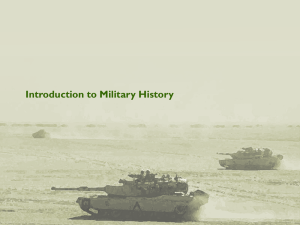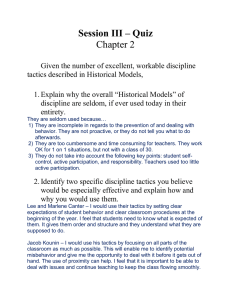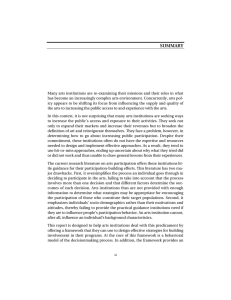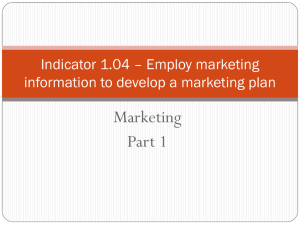DEVELOPING STRATEGIES AND TACTICS
advertisement
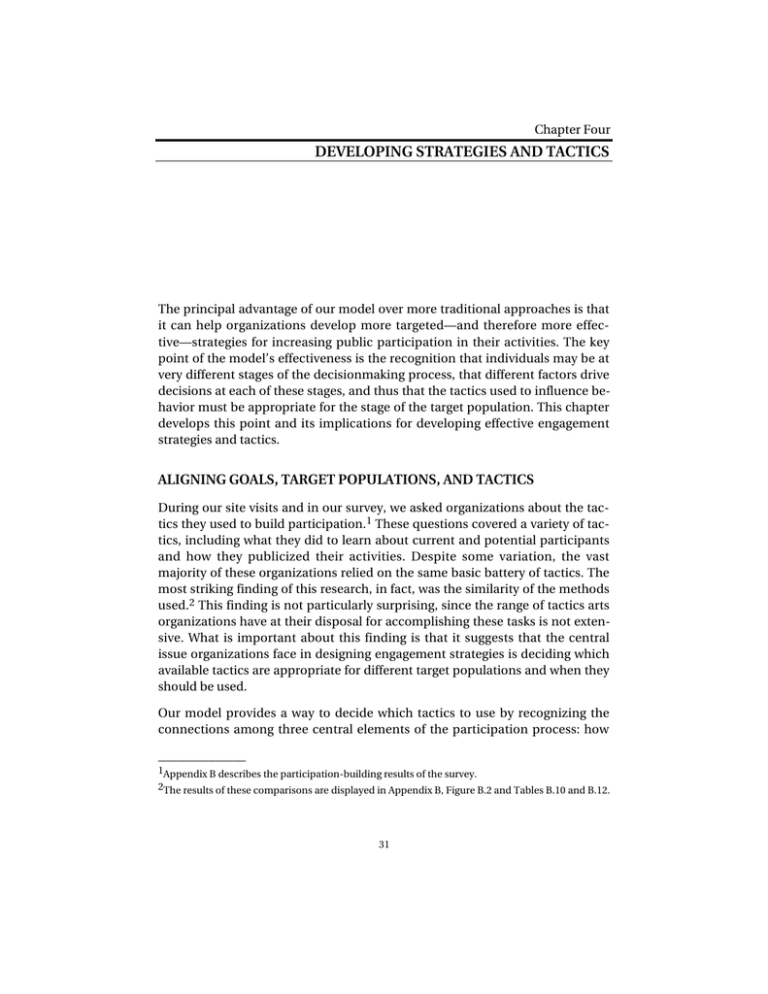
Chapter Four DEVELOPING STRATEGIES AND TACTICS The principal advantage of our model over more traditional approaches is that it can help organizations develop more targeted—and therefore more effective—strategies for increasing public participation in their activities. The key point of the model’s effectiveness is the recognition that individuals may be at very different stages of the decisionmaking process, that different factors drive decisions at each of these stages, and thus that the tactics used to influence behavior must be appropriate for the stage of the target population. This chapter develops this point and its implications for developing effective engagement strategies and tactics. ALIGNING GOALS, TARGET POPULATIONS, AND TACTICS During our site visits and in our survey, we asked organizations about the tactics they used to build participation.1 These questions covered a variety of tactics, including what they did to learn about current and potential participants and how they publicized their activities. Despite some variation, the vast majority of these organizations relied on the same basic battery of tactics. The most striking finding of this research, in fact, was the similarity of the methods used.2 This finding is not particularly surprising, since the range of tactics arts organizations have at their disposal for accomplishing these tasks is not extensive. What is important about this finding is that it suggests that the central issue organizations face in designing engagement strategies is deciding which available tactics are appropriate for different target populations and when they should be used. Our model provides a way to decide which tactics to use by recognizing the connections among three central elements of the participation process: how ______________ 1Appendix B describes the participation-building results of the survey. 2The results of these comparisons are displayed in Appendix B, Figure B.2 and Tables B.10 and B.12. 31 32 A New Framework for Building Participation in the Arts organizations plan to increase participation, where their target populations are in the process of deciding whether to participate in the arts, and what types of factors are relevant to each position in the participation decisionmaking process. Table 4.1 shows how these different elements align. As noted in Chapter One, organizations can build participation in three ways: • They can diversify participation by attracting different kinds of people than they already attract. • They can broaden participation by attracting more people. • They can deepen participation by increasing their current participants’ levels of involvement. As Table 4.1 indicates, in our model each participation goal is appropriate for a specific target population. And the specific target population determines which factors are relevant in devising effective tactics. Thus, for example, efforts to diversify participation are most appropriate for individuals not inclined to participate. These people believe the arts are not likely to be of benefit to them and thus must be persuaded of the benefits they could derive from participation— i.e., they are at the stage in the decisionmaking process where perceptual factors are most relevant. Efforts to broaden participation, however, are most appropriate for individuals already inclined to participate but not currently doing so. These individuals must be provided with information on what types of programs are available, when, and at what prices, and on why these programs might interest them. In other words, this group is at the stage of the process where practical factors are most relevant. Finally, efforts to deepen participation are most appropriate for individuals currently participating. For these people, the challenge is to convince them to become more involved, which means making their participation more rewarding. The key goals here are to increase these people’s knowledge of the art form relevant to them and to instill in them a sense of belonging to the institution’s community. In other words, this group is at the stage where the experience factors are most relevant. Table 4.1 Alignment Among Goals, Target Populations, and Relevant Factors Participation goal Diversify Broaden Deepen Target population Disinclined Inclined Current participants Relevant factors Perceptual Practical Experience Developing Strategies and Tactics 33 EFFECTIVE TACTICS ARE TARGETED TACTICS By suggesting how the different elements of the participation process are related, our model provides a basis for deciding which strategies and tactics an arts organization should use for the three different groups of participants. To increase participation among people not inclined to participate—i.e., to diversify participation—the greatest challenge is to overcome the perceptual barriers and change their attitudes toward the arts. As long as these people view the arts as exclusive, elite, abstract, or otherwise not related to their lives, they will not consider participating. The aim here is thus to make them see the arts as accessible, tangible, and more closely related to their everyday lives. Specific outreach tactics might include programming that relates to their particular interests, sending artists into their communities to discuss art, and helping them recognize the continuum between entertainment forms they may be familiar with (e.g., commercial films, religious music) and the more traditional nonprofit arts (e.g., theater and music). To reach this group, organizations may need to send representatives to non-arts venues where these individuals spend their time and feel comfortable. Another tactic is to emphasize the social aspects of the arts, which might entail approaching individuals through their own social groups and emphasizing the opportunities the arts offer for social interaction. To increase participation among the population inclined to participate but not currently doing so—i.e., to broaden participation—the key is to overcome the existing practical barriers. The main barrier for this group is likely to be lack of information about an organization’s programs and what they offer. Other barriers are inconvenience of the programs, high prices, lack of access to program venues, and childcare problems.3 The aim here is to understand the lifestyles of these people and to adjust accordingly. Getting the needed information to these people may involve first determining the channels they use to get information (the media; personal recommendations from friends, relatives, or community groups; presentations at workplaces, direct mailings, etc.) and the types of messages best for reaching them (messages that emphasize aspects likely to resonate with particular age or ethnic groups or that highlight the creative aspects of the arts). Similarly, to help overcome the practical barriers to this population’s participation, program schedules and locations might be varied, transportation provided, and programs and activities priced more affordably. To increase the level of involvement of current participants—i.e., to deepen participation—the key is to make the arts experiences of these individuals as ______________ 3 All of these barriers were cited by the organizations contacted. See, for example, Appendix B, Tables B.8 and B.9. 34 A New Framework for Building Participation in the Arts rewarding as possible. One tactic for doing this is to increase this population’s knowledge about the arts by providing special events, seminars, workshops, and pre- and post-performance discussions. Another tactic is to enhance the social dimension of the arts experience by offering social events before or after programs, the aim being to develop in these people a sense of belonging to a community. Arts organizations that focus only on the population already participating or on the population not participating but inclined to do so exclude the largest pool of possible participants: the population not even actively considering participation. The general attitude toward the arts of this group, which is in the background stage of our model’s decisionmaking process, is influenced by a variety of background factors, such as socio-demographic and personality characteristics, prior arts experiences (or lack thereof), and group affiliations and identities—all factors over which institutions typically have very little leverage. However, the model suggests that background factors be viewed not as individuals’ fixed inheritances from the past but, rather, as points of connection between arts organizations and potential participants. Taking this view, arts organizations must look for ways to penetrate the “awareness space” of these individuals. One possible approach is to reach out to them through their family or friends. Organizations might, for example, encourage current participants to bring friends and relatives when they attend an event and offer discounts when they do. They might also offer programs in which children learn various forms of artistic expression and which subsequently draw family members into the population of participants (say, as an audience for their children’s performances). In reaching out in ways such as these, an organization becomes a community itself, one with influence over the attitudes and values of potential participants. Another tactic is to conduct active outreach programs with key community organizations, such as schools and churches, to foster arts programs that will help children and their families develop positive attitudes toward the arts. Organizations can also go to workplaces and public meeting spaces in the community to publicly display their art in an effort to raise awareness both of the arts in general and of their specific offerings. Subsequent to such community outreach efforts, institutions should follow up with the individuals contacted to encourage them to consider more active involvement with the arts. INFORMATION IS CRITICAL TO THE ENGAGEMENT PROCESS As this discussion suggests, information is critical to the design and implementation of effective engagement strategies. This information must flow in two directions: from potential and current participants to arts organizations and from Developing Strategies and Tactics 35 arts organizations to potential and current participants. Arts organizations, for example, need various types of information about target populations if they are to design and implement effective engagement strategies. Similarly, potential and current participants need information about arts organizations and their offerings if they are to make informed choices. Information Organizations Need About Participants An effective participation-building strategy is a targeted strategy, and three types of information are important to arts organizations attempting to build a targeted strategy. First, since one key to devising such a strategy is understanding where the target population is in the participation decisionmaking process, an arts organization must find out what its target populations’ inclinations toward the arts are. Most organizations can distinguish between those who currently participate and those who do not, but this distinction alone is not sufficient. They must also be able to differentiate nonparticipants who are inclined to participate from nonparticipants who are not so inclined. This distinction is important because the tactics devised to influence the groups’ decisions need to be different (i.e., they must aim at different factors). The second type of information concerns people who are inclined to participate. People in this group consider many issues before actually deciding to participate (what form their participation should take, what discipline it should involve, which institution to choose, etc.), so devising an effective strategy for attracting these people requires information about their motivations (e.g., whether they are looking for entertainment or enrichment, and whether they are more likely to prefer self-focused or social activities). An understanding of the relevant motivations can help arts organizations identify which individuals are likely to be inclined toward their organization and how best to convey their message, and thus is useful in devising a strategy. In addition, the issue of artistic mission comes into play. Organizations do not all emphasize the same artistic missions. Some emphasize the creative aspect of their art form by stressing training and creativity and putting the individual participant at the center of their activities. These types of organizations may be particularly appealing to individuals who are more interested in hands-on activities—e.g., those who are self-focused and oriented toward enrichment and fulfillment (see Chapter Two’s discussion of motivations). Other organizations focus on the arts as a vehicle for enhancing communities. For them, stressing the social aspects of participation may be more appropriate. Still other organizations are primarily interested in promoting the canons of specific art forms by fostering an appreciation of their art. For these organizations, the potential audience may well consist of two types of 36 A New Framework for Building Participation in the Arts participants—casual attenders and aficionados—which means they may need different appeals for these two groups. Third, and finally, arts organizations need specific information about the lifestyles, specific program interests, and leisure activities of potential participants and how these groups stay informed about their leisure activities. With this information, arts organizations will be able to adapt their programming, scheduling, pricing, and marketing efforts to the specific needs of the potential audiences. The types of information just described may be correlated with the kinds of traditional socio-demographic data often available from marketing organizations, but none is directly demographic per se. Rather, these types of information describe the attitudes, inclinations, motivations, and tastes of potential participants. This difference is important, because when we asked the organizations in our survey to describe their target populations, over three-quarters of them defined those populations in socio-demographic rather than behavioral or attitudinal terms.4 It is interesting to compare the three types of information we see as important to participation-building strategies with what the arts organizations we surveyed reported about their current and target populations and the methods they used to obtain that information.5 As might be expected, these organizations reported that they knew considerably more about their current participants than about their target populations. Although almost two-thirds of them said they knew very much or much about their current participants, only about one-third said they knew an equivalent amount about their target populations. Conversely, while close to one-quarter knew “little” or “nothing at all” about their target populations, less than 5 percent knew little or nothing about current participants. As for how the institutions obtained this information, they told us they used several informal and formal techniques: discussions with staff, with advisory committees, and with community members (informal); and surveys, focus groups, and other traditional marketing means (formal). The organizations were far more likely to use informal than formal techniques to learn about participants, and each of the three informal methods was used more frequently than any one of the formal methods. The most frequently used informal method was discussions among staff. Using informal methods like these to gather information on current and potential participants may well limit an or______________ 4This point is described in Appendix B, Table B.4. 5The information presented here is discussed more fully in Appendix B and displayed in Table B.6 and Figures B.2 and B.3. Developing Strategies and Tactics 37 ganization’s ability to measure the kinds of behavioral and attitudinal factors needed to develop effective engagement strategies. And the most frequently used formal method, surveys (used between a fair amount and much of the time), most often provided information only on current participants. Information Participants Need About Organizations Just as arts organizations need information about current and potential participants, so too do participants need information about arts organizations and what they have to offer. The types of information participants need, however, vary depending on where the individuals are in the decisionmaking process. For individuals not inclined to participate in the arts, the key challenge is to convince them of the arts’ benefits to them. These people thus need information that makes them conscious of the arts and their benefits. One tactic for reaching these people might be to frame the institution’s message in terms of the advantages offered by the arts compared with other leisure activities. For people inclined to participate but not currently doing so, the challenge is to convince them to sample the organization’s offerings. To meet this challenge, organizations need to provide basic information about the activities they offer, including when, where, and at what price. In addition, they need to market their activities in a way that persuades individuals to participate—i.e., by linking the activities to potential participants’ specific interests. Finally, for those already participating, the challenge is to convince them to increase their level of involvement. The key here is to make the participation experience as enjoyable and rewarding as possible by increasing these individuals’ understanding and knowledge of the arts How to Convey Information to Potential and Current Participants Focusing on the information needs of the three different groups is only part of the information picture. The effectiveness of outreach strategies hinges on both the substance of the message conveyed and how that message is delivered. Information channels differ, not only in their ability to reach different populations but also in terms of their credibility. We have no a priori reason to differentiate among information channels along these dimensions, but we did ask the organizations we surveyed to describe how they communicated with current and potential participants and how effective these communication efforts were. We did not ask these organizations to distinguish among our three types of participants, however, so our results make no distinctions as to intended audiences. 38 A New Framework for Building Participation in the Arts Our survey results indicate that the interviewed arts organizations place a high priority on publicizing their activities and use a combination of resources for this task. We asked them about their use of ten techniques: word of mouth, free media, direct mail, presentations to community groups, community collaborators, handouts, paid media, the Internet, personal telephone calls, and billboards. Seven of the 10 were used by almost 90 percent of the organizations, and no technique was used by fewer than 50 percent.6 Every organization relied on word of mouth and free media publicity, almost all used direct mail, and between 80 and 95 percent used presentations to community groups, community collaborators, handouts, paid advertisements in the media, and the Internet. The two least popular techniques were personal telephone calls and billboards. There was considerably less agreement about the effectiveness of these different techniques. Word of mouth and direct mail were rated as the two most highly effective techniques, yet they were rated as highly effective by only 40 percent of the organizations. Interestingly, both of these techniques rely on an already established link between the organization and its participants. Word of mouth relies on contacts among family and friends of potential participants, and direct mailings are sent out to those who either have already participated at an institution or are on a mailing list obtained from another organization (and thus might be expected to have participated there). Free media publicity in the form of general interest stories about the organization or its programs in the local press and paid advertising were also rated as being effective by a substantial number of organizations. These comparisons suggest that there is a discrepancy between the importance our model ascribes to the two-way exchange of information between art organizations and potential and current participants and what the arts organizations we surveyed said about their information collection and dissemination tactics. By and large, the organizations were much more likely to rely on informal than formal techniques to collect information about participants, and of those informal techniques, discussions among staff were used the most. This may well explain why these organizations generally knew much more about their current participants than about their target populations. Moreover, it is unclear whether these informal techniques are well suited to collecting the attitudinal and behavioral information about participants that is essential to developing effective engagement strategies. These comparisons also raise questions about how arts organizations deliver their message to current and potential participants. These organizations clearly understood the importance of conveying their message to potential partici______________ 6The results of our comparisons are reported in Appendix B, Table B.10. Developing Strategies and Tactics 39 pants, but their effectiveness in doing this is unclear. Despite the fact that these institutions used a wide variety of techniques, no more than at best 40 percent of them rated these techniques as effective in delivering their message. Given the diversity of their approaches, we suspect that the problem does not lie in the delivery channels they use per se but, rather, in knowing when to use the channels and for which groups. As our model suggests, the key to effective information dissemination is to understand the behavior and attitudes of the target audience and to tailor the tactics used accordingly. If arts institutions lack a firm understanding of these characteristics, they will not be positioned to develop the right message, regardless of the channels they choose for its delivery.
